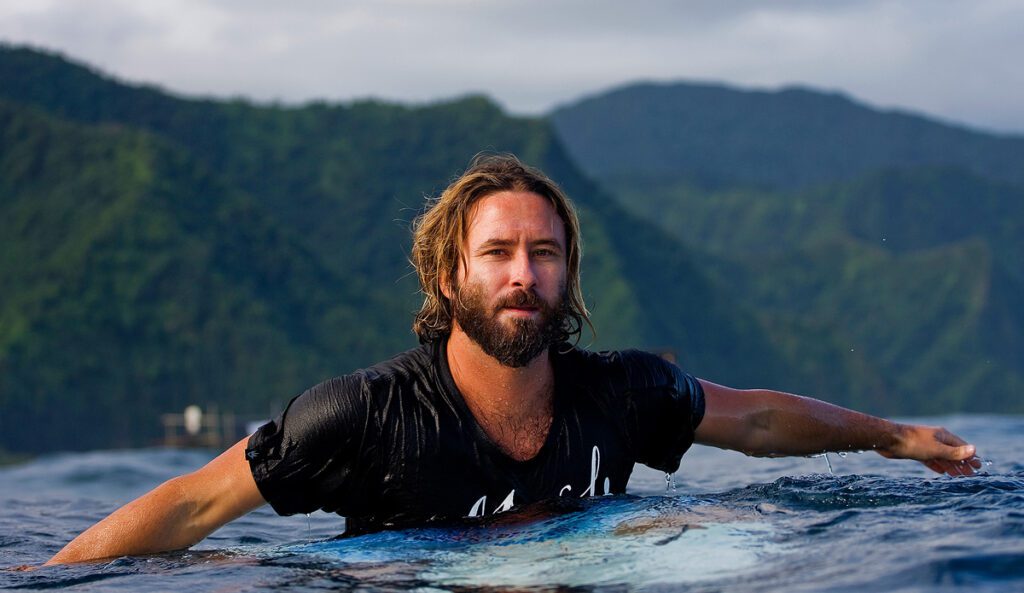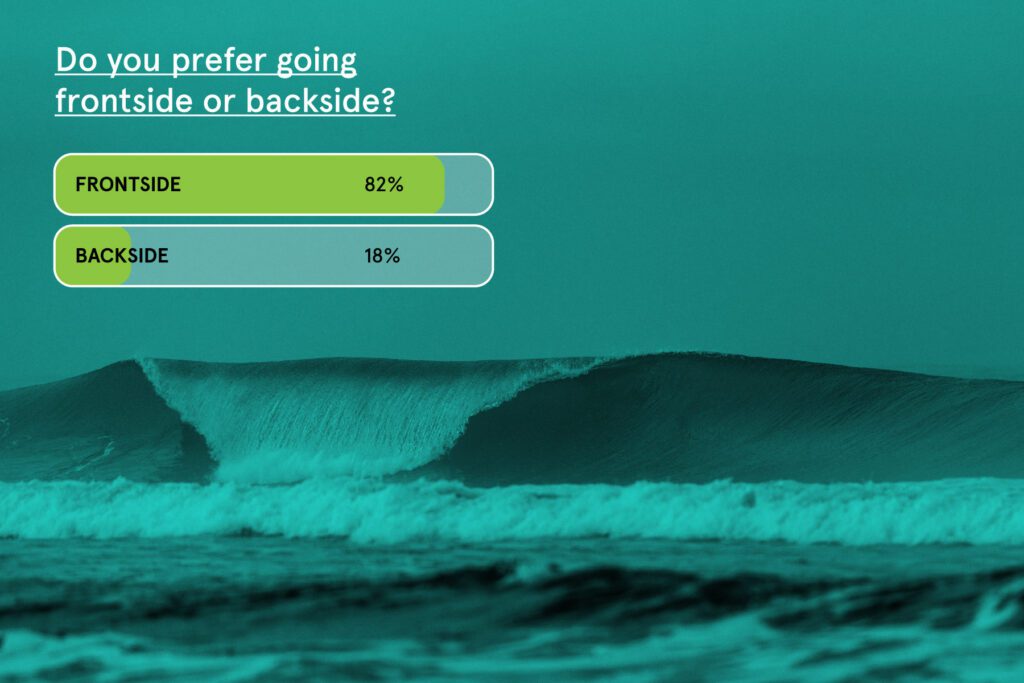Does Switch-Stance Have A Future In Surfing?
A balanced take on where we’re at now, and where we could be heading.
Championship Tour events don’t always succeed in stimulating arousal or fuelling human imagination.
Yet, I think most would agree the recent shindig in Tahiti was a good one.
Impeccable location, female participation, copious tubes, finals-deciding heats. You’ll read no complaints here.
One issue, however, did raise its ambiguous little head.
If you will, direct your attention back to men’s Semifinal 1. An invigorating affair between Tahitian local Kauli Vaast and event sponsor, K. Slater, a man thirty years his senior.
The most intriguing matchup of the Pro in my book.
Midway through the heat, the uber-talented and goof-footed Vaast took off switch (i.e., backside), negotiated a series of scrappy cover-ups, then, upon emerging from the funnel, completed a sneaky switcheroo back to goof before landing a final blow to a curling Teahupo’o lip.
Eyes watered among those in the channel, many in disbelief as to what they had just witnessed.
Scores dropped: 6.77.
The response from the judges caused many a perplexed sideways glance. ‘Underscored!’ many of you cried from living room sofas across the globe.
The score caused quiet alarm, raising questions such as how is switch-stance surfing approached in the judging booth, why don’t we see more switch surfing among elite competitors as we do in other board sports, and is the current judging criteria supporting or inhibiting progressive surfing in general?

6.77: Right or wrong?
First, an announcement. The intent of this piece is not to tangle ourselves in the weeds of an individual judging decision, which is pedantic and tiresome. Judging, refereeing, and umpiring involve arduous and ongoing analysis, so it’s wise not to overlook the one-hundred correct decisions they make for every one you feel they got wrong.
Sure, we’ll examine the specifics below, but let’s keep our minds open and focus on bigger questions.
The overwhelming majority of commenters on this WSL Instagram post vigorously maintain that Kauli was not sufficiently bathed in points for his display.
While League commentators Pete Mel and Kaipo Guerrero selected their words delicately, it didn’t require a great between-the-lines reader to hear their dismay at the injustice.
Pete: For me, I think that’s excellent. I truly think you need to reward something that no one else in the draw can really do.
Kaipo: This is a high degree of difficulty. Switching stance to an unnatural stance, grabbing a rail and weaving through a barrel, through a couple of sections. Here’s the scores and I don’t think the judges appreciated it as much as we did, Pete.
Pete: No, I just think that if you want to have the sport go in the direction that we need to see progression go, that’s one way to do it. (i.e., reward progressive surfing).
Kaipo: Not to say that one went over their heads, but I thought that was super, super impressive.
Even the WSL’s own Insta post of the wave, captioned ‘WOW @kaulivaast put on a clinic in the Semifinal of the #OuterknownTahitiPro and moves into the Final!’ seems a little contradictive. Strange to make a fuss over a wave that only attracted the score that it did.
Kauli’s 6.77 doesn’t appear to pass the pub test. Many believe it was a stingy reward for riding a surfboard in a way that others cannot — or don’t have the courage to attempt — at a wave that is complicated to surf on the best of days.

A judge’s perspective
The more you contemplate how a switch-stance wave can be scored, the more you become aware of the factors and considerations that plague any judge required to allocate points.
It seems only fair that we get the switch-stance lowdown from the WSL. Here’s an unedited explanation from Head Judge, Pritamo Ahrendt, on why they awarded the number they did.
Firstly, I totally understand the desire to get some understanding of the scoring for Kauli’s switch-stance barrel. It has been a long time since we have had a legitimate switch-stance barrel in a CT.
As Teahupo’o is primarily a barrel wave, the main elements we focus on for judging are:
- Commitment to ride the biggest and/or heaviest barrels.
- Deep and technical barrel riding
In this heat, we already had a 6.83, 8.5, and 8.83 to have our comparisons when Kauli rode his switch barrel that scored a 6.77. This ride was very technical, but he was never very deep and it wasn’t on a big or heavy wave comparative for the day.
After the judges had put their initial score into the computer and we watched the replay, I asked the judges what they thought the barrel would have been worth if it was not ridden switch to get an idea of how many extra points they were giving. The feedback was that it would have been no more than a low 5, which I agree with. He was never very deep, and the first section was crumbly. We felt that an extra 1.5+ points for a switch wave was fair.
Even with the technical aspect of going switch, we still have to score the type of barrel and depth that it was ridden and compare it to the other major scores of the heat (8.5 & 8.83), and that’s why it couldn’t go near the excellent range. If he had gone switch on one of the thicker and heavier barreling waves, he could have received a much higher score.
Obviously, it takes a lot of skill to ride switch in a multi-section barrel, and also the way he jumped back to his normal stance to do the turn. His style and approach looked good, but he was grabbing the rail and had his back leg flat on the board from the takeoff until the end of the barrel.
Agree or disagree, but the response gives you a sense of the complexity involved in handing down Kauli’s 6.77. Can you honestly say that you considered all of those issues before you reached your own judgement?

What do the neighbors think?
Let’s take a casual stroll through the professional surf, snow, and skate rule books to uncover how each approaches switch-stance rides.
Surf
Surf judging is a subjective beast made quasi-objective through a set of criteria:
- Commitment and degree of difficulty
- Innovative and progressive manoeuvres
- Combination of major manoeuvres
- Variety of manoeuvres
- Speed, power and flow
The rules also highlight that judges can focus on any number of these points based on location and conditions, adding a further layer of complexity to an already imprecise process.
It’s easy to be left scratching one’s head when considering how Kauli’s commitment, degree of difficulty, innovation, and progression barely succeeded in thrusting his score into the ‘Very Good’ range (6.5-7.9).
However, following Mr. Ahrendt’s explanation, if the scoring focus is on ‘commitment to ride the biggest and/or heaviest barrels’ and ‘deep and technical barrel riding,’ then you can see how the progressive aspect of Kauli’s work wasn’t exactly the center of attention. Rightly or wrongly.
Snow
The International Ski and Snowboard Federation’s (FIS) judging criteria is far more prescriptive. Its criteria consist of:
- Execution
- Difficulty
- Amplitude
- Variety
- Progression
Within these five points, both difficulty and variety dedicate sub-sections to switch-stance maneuvers. Progression also incorporates this into the criteria:
If a competitor displays a trick, trick variety, grab, or anything that stands out as new, unique, rare, innovative, or creative for that level of competition, judges can recognize that as progression.
Skate
The World Skateboarding general criteria are:
- Difficulty and variety of performed tricks
- Quality of execution
- Use of course and individual obstacles
- Flow and consistency
- Repetition
No specific detail about switch-stance, yet undoubtedly a significant part of competitive skate.
The judging criteria of surf, snow, and skate are seemingly scratching the same itch, albeit with some tweaks relevant to their individual sport. All three disciplines have scope in their rules to incorporate and reward switch-stance rides.
But rules and judging criteria are not the only aspects that count. Riding (or at least finishing a manoeuvre) switch is far more integrated in both skating and snowboarding culture. If you aren’t able to ride competently in your non-preferred stance, then your skate/snow career will be limited.
The big point of difference is surfers don’t need to surf switch.
Competitive surfing doesn’t require it. More on this below.
Why don’t more competitive surfers ride switch?
Sadly, examples of switch-stance surfing are few and far between, especially in a competitor’s guernsey. It’s probably best not to expect more any time soon.
As any behavioral economist will point out, there is, seemingly, a lack of incentive to surfing switch. This goes to the very core of why we don’t see more of it. Although given the almost non-existence of switch maneuvers, this argument remains largely untested.
Is there any value in changing your stance to surf a wave? For every possible turn or maneuver done on one’s frontside, isn’t there an equally impressive version of that turn or maneuver that can be done on one’s backside? Is there really any point in switching? Perhaps not. Or at least not yet.
Are the current criteria hindering progression? Given the high degree of difficulty and risk involved in Kauli’s effort, could you blame future CT competitors for doing away with any switch-stance attempts at Teahupo’o, given the paltry 1.5 (ish) points on offer?
Keep in mind there was once a time when airs were heavily shunned in the judging booth. Competitive surf culture is fluid and judging criteria does (eventually) catch up. Maybe Kauli wasted his time risking his semi-final ride, but that wave might attract a very different score in two-or-three years’ time.
Other reasons impeding switch in surfing involve two sport science concepts known as skill acquisition and time on feet.

Skill acquisition tells us that many behavioral and intellectual skills are more easily learned in our younger years. Learning to surf is hard. Learning to surf at a competitive level is harder. Learning to surf on your non-preferred stance at a competitive level….you know where this is going.
Unless surfers are learning to ride switch, or at least perform some maneuvers switch, in their younger years, they will unlikely be able to master it at a high enough level later on.
Time on feet is, unfortunately, a concept that relates heavily to surfing. It highlights the incredibly small proportion of time surfers spend improving their skills, particularly compared to other sports.
Say a surfer spends around eight seconds on average riding a wave, catches about ten waves per session, and surfs five sessions per week. That all adds up to under six hours of actual surfing per year.
Under six hours of actual surfing. Per year.
Fun to imagine the level of competitive surfing if surfers were afforded the same time on feet as snowboarders and skaters.
What does this mean? Time is precious when it comes to skill development. Surfing requires a significant investment of time in water — 260 hours in the example listed above — for only a small return of time on feet.
It’ll take one highly talented individual who can sacrifice valuable hours surfing on their preferred stance to train on their non-preferred and then have the ability to make it to an elite level. Wave tanks could help, but who’s going to sit in a pool all year round?
Any current CS or CT surfers wish to jeopardize their career by spending huge amounts of time in a chlorinated pool training switch, looking foolish, doing it poorly, forgoing edits, irritating sponsors, etc?
Any takers?
Yet, switch is obviously not a new thing. Sure, twenty-year-old Kauli is a contemporary example, but the man he beat in that recent semi-final — that man thirty years his senior — was long-ago slicing Indo tubes backside switch in the film Surfers of Fortune.
Slater was twenty years old at the time.
It’s a big world out there, filled with possibility. Let’s keep things moving forward.
It’s time for something new.





Comments
Comments are a Stab Premium feature. Gotta join to talk shop.
Already a member? Sign In
Want to join? Sign Up